

LAID
LSU football suffers first loss of the season to rival Ole Miss.
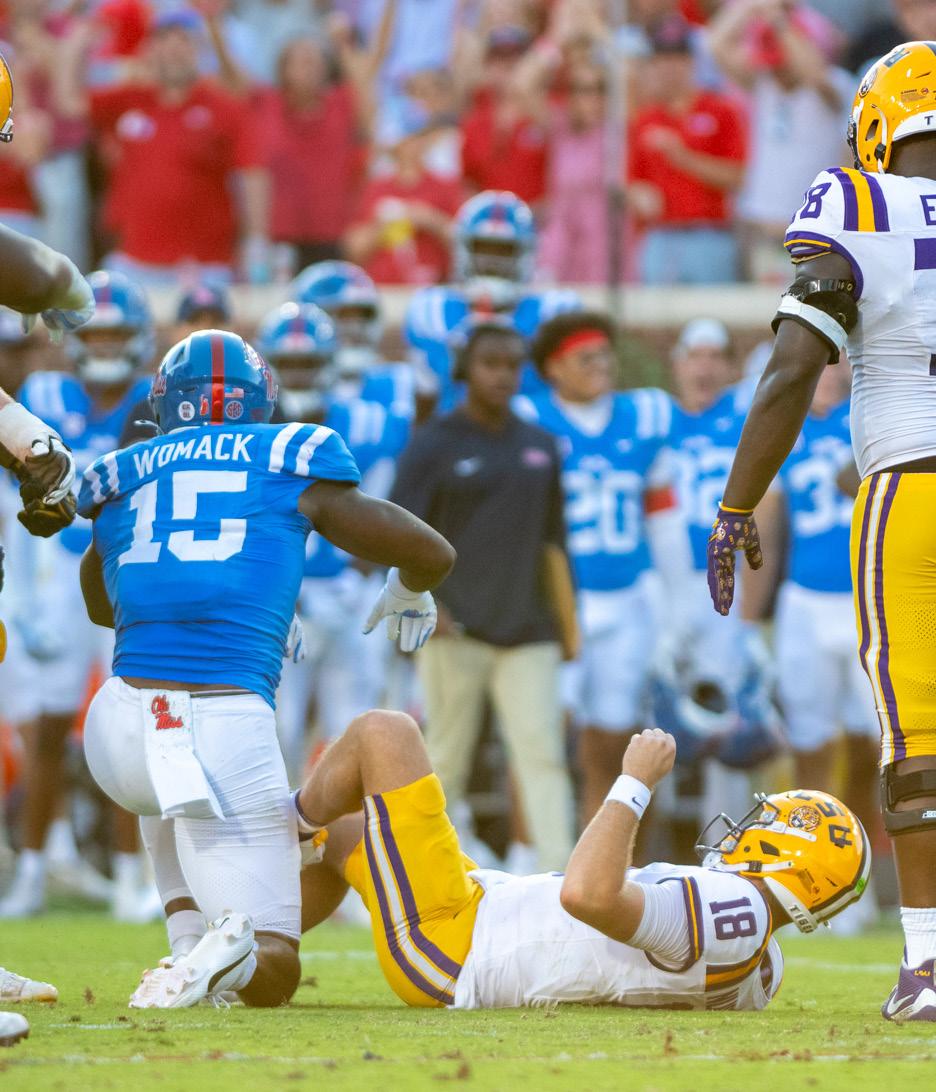



OFFENSE EXPOSED
LSU
offense squanders key scoring opportunities in loss to Ole Miss
BY TRE ALLEN Staff Writer
In a game where you can feel the hostility and the hatred brewing within the stadium, every point and opportunity matters.
On a play that looked to be a touchdown to give the Rebels the lead in the second quarter, safety AJ Haulcy did his best Charles Tillman impression and punched the ball out near the goal line. Whit Weeks jumped on it in the end zone, and it was a momentum-changing fumble recovery for the Tigers.
LSU led 7-3 at the time, but Ole Miss was gaining rhythm on offense. If the pass was caught by wide receiver Cayden Lee, that would’ve put the Rebels inside the 5-yard line. The punch out by Haulcy saved the Tigers that time.
Not only was it a big play to prevent points added to the board, but it also made up for the costly interception that quarterback Garrett Nussmeier threw on the previous drive that potentially made it a twoscore game for the Tigers. The play by Haulcy kept the Rebels off the board and killed any momentum.
Whichever team takes advantage of mistakes or big plays is often the one to win the game. For the Tigers, it wasn’t them. Ole Miss defended its home turf with a 24-19 win over LSU.
The LSU offense in the first half was nothing more than inconsistent. Plays such as the 50yard reception to Zavion Thomas and the tipped touchdown catch by Nic Anderson showed flashes of what the offense

could be for the rest of the year.
However, with drives no longer than five plays and Ole Miss having 49 total plays in comparison to LSU’s 24, the offense was once again depending on the defense.
“We didn’t play complementary football, which you have to do in this league,” head coach Brian Kelly said. “You have to be able to complete your offense and defense, and we were out of sync with that.”
But once again, the defense

delivered.
The unit forced a punt on the Rebels’ first drive out of halftime after the offense had to punt on its first drive. LSU responded by adding three to the board to make it a one-possession game at 17-10.
It was an overall good performance from the defense, which was out on the field for the majority of the game. But like any defense, if it’s out there for too long, it gets worn out.
It did its job for most of the game and held an Ole Miss offense that averages 44.8 points per game to 24 points and forced two turnovers, including an interception by cornerback PJ Woodland in the third quarter that gave LSU the football on the Rebels’ 47-yard line.
Despite the great field position, LSU only came away with another field goal to make it 1713. Points are what you need when you enter enemy territory, but field goals won’t cut it.
The Tigers had two chances to make it a different ball game, yet the offense could only muster up field goals on the road, even with the defense keeping LSU in the game.
While the LSU offense started to pick things up in the second half, the number of missed opportunities started to pile up and eventually came back to haunt the Tigers.
A drained and exhausted defense was relied on to make the final stop of the game to give the LSU offense a sliver of hope near the end, but an easy, wide-open throw to Dae’Quan
Wright was all Trinidad Chambliss needed to get first down. With 1:37 left on the clock, the Rebels iced the game and solidified LSU’s first loss of the season.
Head football coach “ ”
We’re not clicking on all cylinders right now.
BRIAN KELLY
The Tigers not only didn’t take advantage of opportunities but also gave them away.
Nussmeier threw a pick in Ole Miss territory in the second quarter, eliminating any chance for points and extending the lead.
A game that’s won and lost just by a few plays was decided when the Tigers couldn’t produce the game-winning plays that they needed.
“This team has to click on all cylinders, and we’re not clicking on all cylinders right now,” Kelly said. “I believe in this team, I love this group, they’re real good football players, but we’ve got to complete them on a day-to-day basis.”

B-16 Hodges Hall Louisiana State University Baton Rouge, La. 70803
ADVERTISING (225) 578-6090
Layout/Ad Design
Layout/Ad Design
The Reveille incorrectly spelled the name of Homecoming Court member Taylor Davlin in the Sept. 25 edition of the newspaper.
The Reveille holds accuracy and objectivity at the highest priority and wants to reassure its readers the reporting and content of the paper meets these standards. If you would like something corrected or clarified, please contact the editor at (225) 578-4811 or email editor@lsu.edu.
CORRECTIONS & CLARIFICATIONS ABOUT THE REVEILLE
The Reveille is written, edited and produced solely by students of Louisiana State University. The Reveille is an independent entity of the Office of Student Media within the Manship School of Mass Communication. A single issue of The Reveille is free from multiple sites on campus and about 25 sites off campus. To obtain additional copies, please visit the Office of Student Media in B-39 Hodges Hall or email studentmedia@ lsu.edu. The Reveille is published biweekly during the fall, spring and summer semesters, except during holidays and final exams. The Reveille is funded through LSU students’ payments of the Student Media fee.
PAYTON PRICHARD / The Reveille
LSU football redshirt junior linebacker Princeton Malbrue (52) hypes up the crowd during LSU’s 19-24 loss to Ole Miss Sept. 27 at the Vaught-Hemmingway Stadium in Oxford, Miss.
PAYTON PRICHARD / The Reveille LSU football freshman cornerback DJ Pickett (3) runs down the sideline during LSU’s 19-24 loss to Ole Miss Sept. 27 at the Vaught-Hemmingway Stadium in Oxford, Miss.
NEWS ANTI-HAZING
LSU Greek Life celebrated Hazing Prevention Week
BY KALEY MELANCON Staff Writer
LSU’s Greek Life community came together last week to raise awareness for National Hazing Prevention Week.
All week long, Greek Life celebrated with fundraisers, activities and tabling in an effort to promote anti-hazing awareness. LSU does not allow for any hazing on campus or as a part of Greek Life.
To start off, students were given a ride with an anti-hazing themed version of “Cash Cab.” Dean of Students Fran’Cee Brown-McClure rode around campus in a golf cart asking students about hazing facts and myths.
Brown-McClure asked students questions like who can be a victim of hazing, if it must include alcohol and whether it can happen outside of sports and Greek Life.
While students did not walk away with cash, the activity provided a simple understanding of hazing and its consequences.
Members of Greek Life publicly displayed their promise of anti-hazing on Wednesday at Free Speech Alley. A banner stating “LSU Greeks don’t haze” was open for members to sign.
Dylan Weinrich, a Greek ambassador co-lead and a member of Delta Tau Delta, said tabling events are a great opportunity to spread the word about the harms of hazing. Weinrich said

with hazing being a big issue across the country, it is something Greek Life cares a lot about.
Hazing has been an issue at LSU. In 2017, freshman Max Gruver died of alcohol poisoning after a Phi Delta Theta hazing ritual. According to hazinginfo.org, this was just one of 18 hazing incidents at LSU since 2018.
“It is a way for us to represent our community and show our commitment to standing against hazing,” Weinrich said.
In some cases, hazing prevention knowledge came with a refreshing drink — or a pie to the face. The Latin sorority
Student Health Center offers nutrition counseling
BY TORI BONIN Staff Writer
LSU offers many different services to students to help with their college career. One surprising service is nutritional counseling to help them meet their health goals and create a better relationship with food.
Emily Caire has worked at LSU Health Center as a registered dietitian for the past nine years. She not only helps with campus outreach but also works one-on-one with students to help them with their nutrition goals. Caire expresses that each student’s experience is based on their personal needs.
“The resources and information provided are going to be based on their individual needs,” Caire said. “For exam -
ple, it might include information about balance, nutrition, heart health, maybe navigating gastrointestinal challenges or even a healthy relationship with food.”
For students who have allergies or dietary restrictions, there is a campus dietician who will work with LSU Dining to help students navigate those challenges.
Caire said that it is important to understand the potential misinformation about nutrition and understand its balance.
“I think once we get past potential misinformation about nutrition, understanding balanced nutrition is an easy part and it’s applying it that can be challenging,” Caire said. “I usu -
Campus groups make care packages for the formerly incarcerated
BY KALEY MELANCON Staff Writer
LSU clubs gave back to the community on Saturday with care packages for those re-entering society after incarceration.
The Innocence Club, Injustice Reform and Black Pre-Law Scholars Association joined forces to give everyday essential items to individuals leaving prison. The packages will be given to the Parole Project, which helps people re-enter society after at least 20 years in
state penitentiaries.
Eight rows of tables filled up the room as participants packed items like deodorant, soap, a toothbrush and toothpaste, socks and candy in a Ziploc bag. These items were collected through the Innocence Club’s “Bridge The Gap” drive.
“I didn’t expect this many people to show up,” said Kayla Drummond, vice president of the Innocence Club.
Drummond said most of those who will be re-entering
Lambda Theta Alpha used its fundraiser to pay homage to their culture.
The chapter was selling aguas frescas, a traditional Mexican drink made from fruit, for $3 to help support future chapter events. Students could choose from mango, coconut, pineapple or tamarind flavors.
Along with the drink, the sorority distributed flyers to students with information on hazing. The handout included a quiz, examples and quick facts.
Alison Rocha, a member of LTA, said it is important for students to know the range of
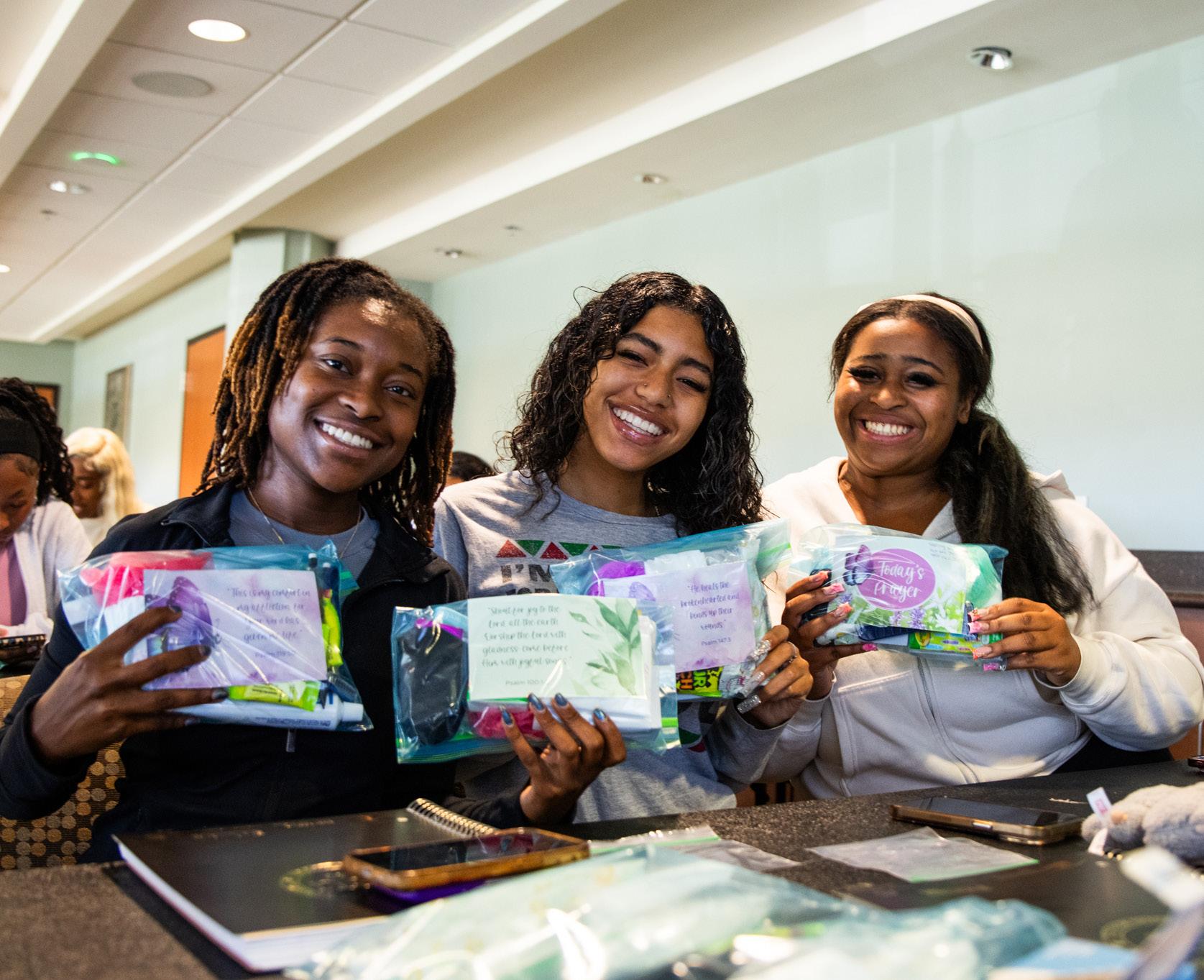
STUDENT GOVERNMENT
Student Senate passes bill calling for LSU to address federal funding cuts
BY MORGAN VANNOSDALL Staff Writer
The Student Senate passed a resolution urging LSU to make a statement on the impact students will face with the current proposed federal funding cuts at their second regular session Wednesday.
The resolution would urge LSU administration and the Office of Academic Affairs to acknowledge and release a statement on these potential cuts and ask them to provide other resources and possible alternatives for students in need.
The federal funding cuts would apply to the TRIO programs created to help students from disadvantaged backgrounds, includ -
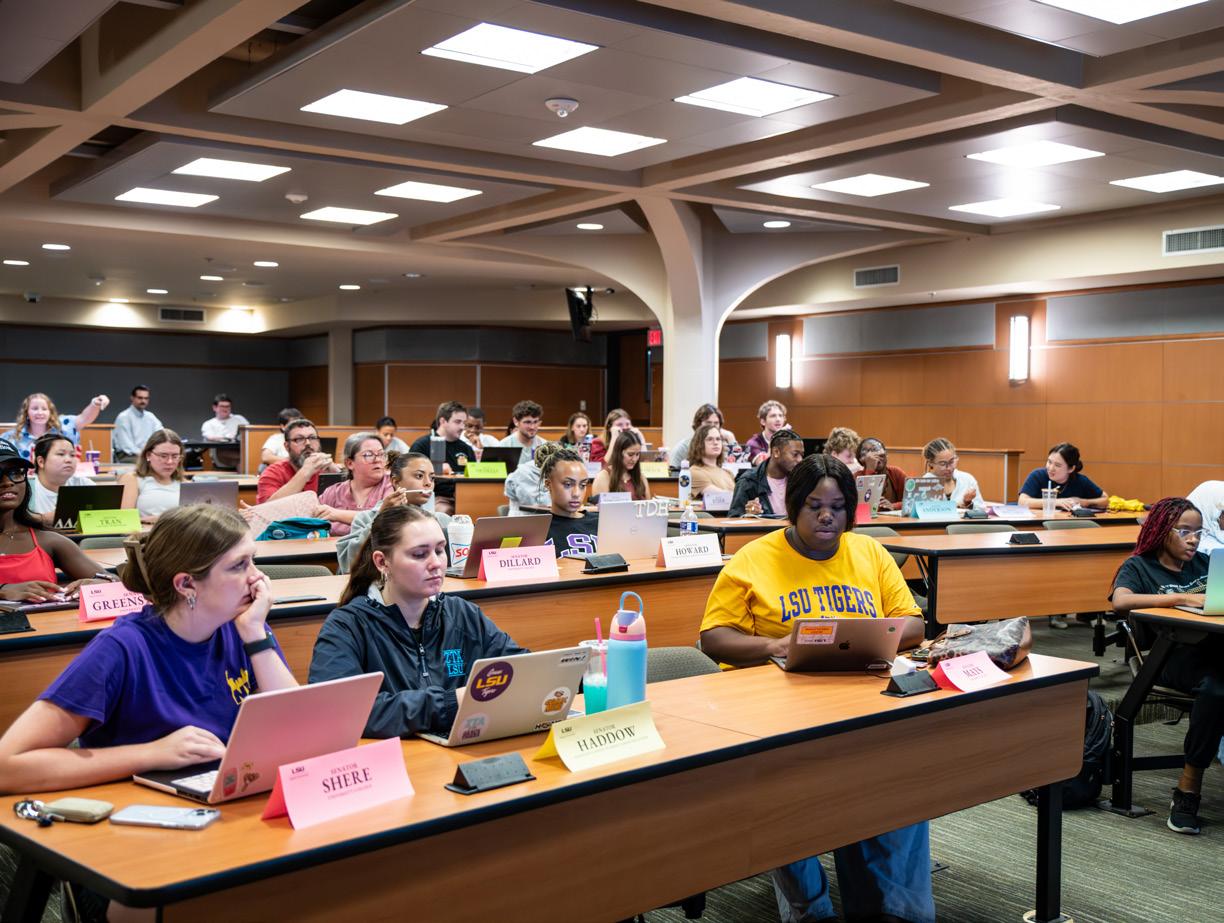
see CARE PACKAGES, page 4
ALEXIS PERSICKE / The Reveille
LSU Omega Psi Phi members at the hazing prevention event Sept. 24 at Free Speech Alley in Baton Rouge, La.
CAMPUS LIFE
COLE TAMPLET / The Reveille LSU students listening Sept. 24 during the LSU Student Senate meeting in the Student Union in Baton Rouge, La.
ERIN BARKER / The Reveille
The President of LSU Injustice Reform assembles reentry care packages with members Sept. 27 in the LSU Student Union on Highland Road in Baton Rouge, La.
HAZING, from page 3
hazing. It could be as minor as telling someone what to do or as major as doing something dangerous, said Rocha.
Other chapters put its members on the front line in the name of anti-hazing. The fraternity, Omega Psi Phi, allowed students to pie members with shaving cream.
Participants could choose to get one pie for $3 or three for $5. The money earned would go to future events the chapter holds on campus, said Jeremiah Wilson, a member of the fraternity.
One by one, students did not hold back as they smushed a pie in different members’ faces. Some students specifically waited to pie a certain member of their choice.
Wilson said being a part of anti-hazing as a member of the chapter means speaking up when needed and knowing when something is wrong.
“We live in the 21st century, hazing needs to be stopped to this day,” Wilson said.
Due to rain, the fundraiser was cut short but has been rescheduled for later this month.
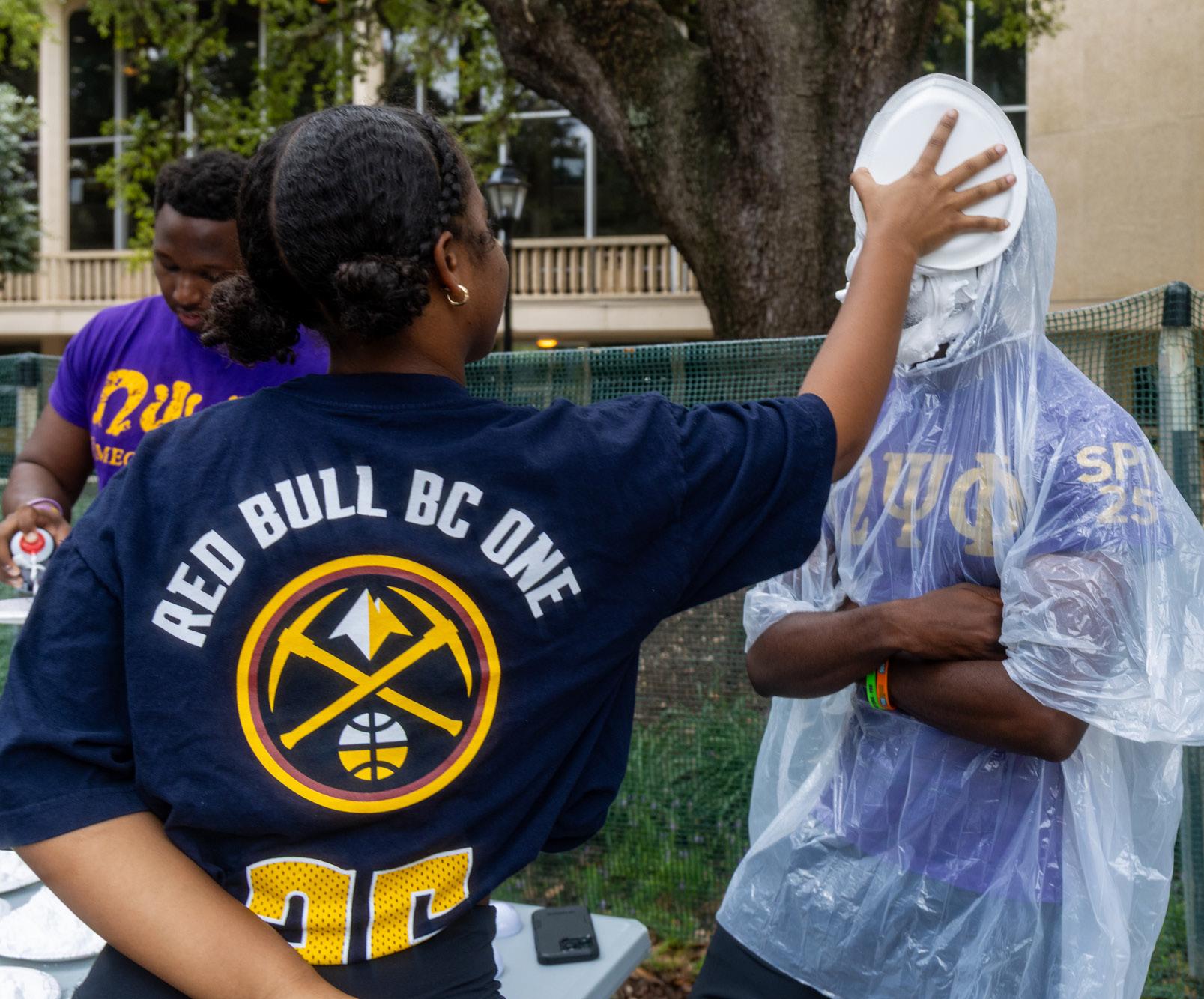
Rain or shine, LSU offers yearround anti-hazing education opportunities.
Weinrich said multiple speakers come to the university throughout the year to talk about anti-hazing. All students involved in registered organizations at LSU are required to
go through hazing prevention education.
To end the week, Greek Life encouraged all students to wear purple in support of hazing prevention.
“Taking the time to spread awareness, it goes a long way,” Wilson said.
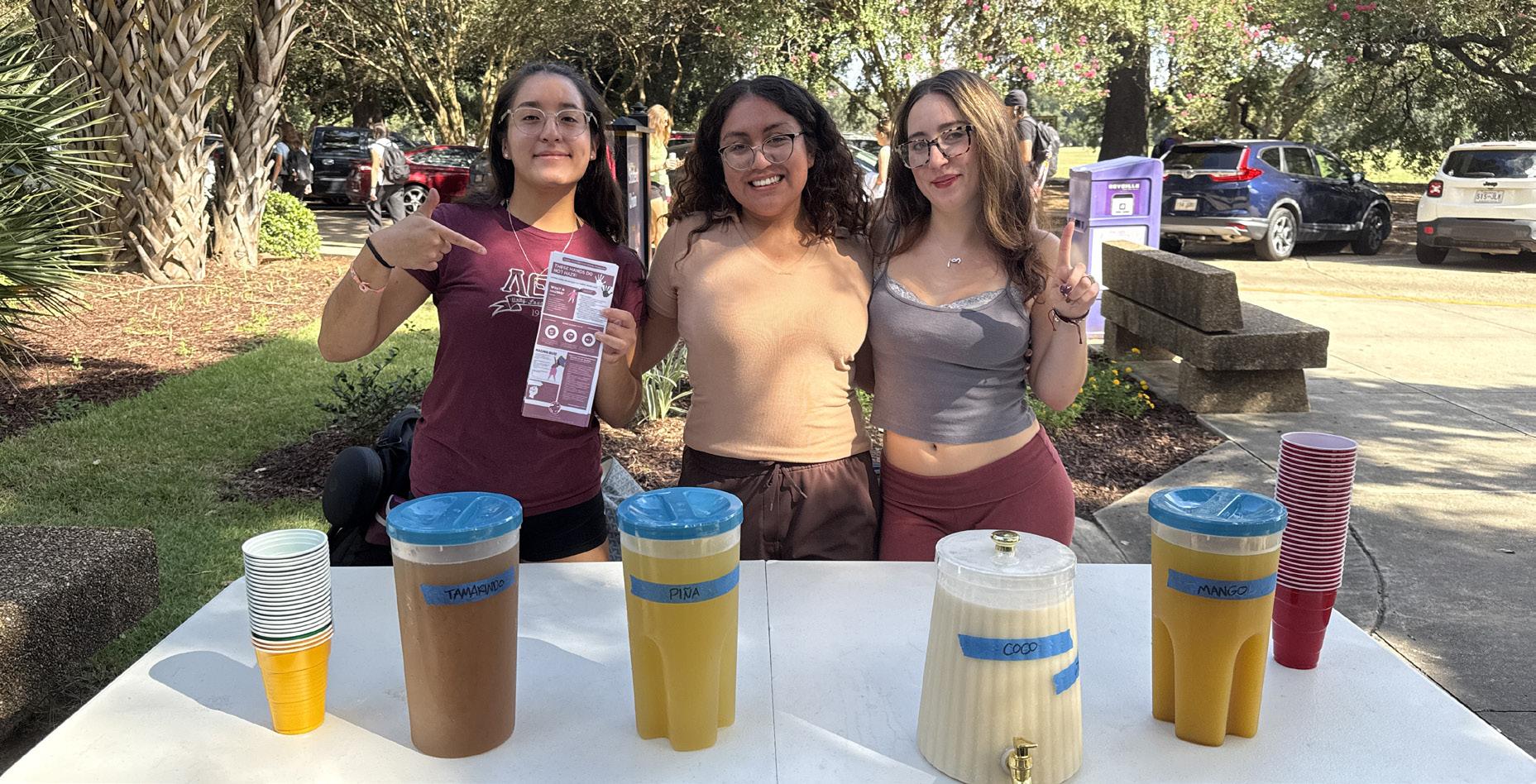
NUTRITION, from page 3
ally say a little bit of planning can go a long way with supporting our goals. The hard part is applying the things we know and navigating the challenges and barriers or obstacles that we may face.”
According to the U.S. Government Accountability Office, 23% of college students faced food insecurity in 2020.
Caire wants students to be aware of the LSU Food Pan -
STUDENT GOV, from page 3
ing the Upward Bound and the McNair Scholars programs. SGR 2 mentions how these programs help around 870,000-880,000 students across the country.
Multiple members of the Senate urged for the passing of this resolution including College of Music and Dramatic Arts Sen. James Williams III.
try which is available Monday through Friday and offers students free food and groceries.
The pantry runs on donations from Walmart, Trader Joe’s, Whole Foods and the Greater Baton Rouge Food Bank.
Each LSU student has a success team that is built to help students succeed and Caire’s wish is that students take advantage of all their resources.
She said that if students aren’t sure where to turn that a member of their success team can
“These are pathways that do a lot for incoming students,” Williams III said. “It is horrific how these programs are being treated when they provide such incredible experiences.”
The Senate decided in favor of the resolution and there was a motion to suspend the rules and pass by unanimous consent, which was seconded then passed. Alongside this resolution,
CARE PACKAGES, from page 3
society do not have many resources. She said the club hopes these packages will help the individuals get back on their feet and show there are people who care about them.
Along with providing access to items, the packages will help those who receive them prepare for their environment. Community Service Chair of the Innocence Club Sahana Balde said after re-entering society, a lot of the individuals go back to the environment that led them to prison.
“You never know where they’re going back to,” Balde said.
The lack of resources is why Kobe Wheeler, a member of the Black Pre-Law Scholars Association, decided to help make care packages. Despite a lot of money and resources used to maintain the prison system, Wheeler said there is not much for people once they leave.
Wheeler, a philosophy and political science senior, said he wants to go to law school and is passionate about helping people re-enter society after run-ins with the law.
Passion is all that was needed to get people in the door.
Rosemary Jerry, a theater arts senior, said she was not a part of one of the clubs hosting the event but wanted to come support her community anyways.
Jerry said whether it is through donations or collaborating with others, she tries to help the people around her as much as she can. Jerry said she learned how difficult it is for people to come out of prison in one of her classes. This inspired her to help create these packages.
Students also got the chance to leave a personal message

along with the items in the bag. On the back of prayer cards, each student wrote short, uplifting notes for the individuals.
“Welcome back. You’re going to do great things. Stay motivated and keep going. Good luck,” wrote Elizabeth Brownman, a member of the Innocence Club.
Brownman said she hopes her care package and message gives people a headstart and motivation to find a new path. Regardless of what someone has done, Brownman said she feels like they deserve to come back to something nice.
For some, creating the care packages was a way to return the favor. Ciera White, a member of the Innocence Club and Black Pre-Law Scholars Association, said she remembers people giving back to her when she was young.
White said it’s important for her to give back and do the same thing for someone else. She wrote that her note was “from someone who cares.”
help them find out what services are available on campus.
“I think there is so many services available to support student well-being, which in turn supports their ability to succeed in all areas of life,” Caire said. “If they are struggling in a certain area and might not know where to go, starting with a member of their success team can help potentially get them some answers about ‘Is this something a service on campus can support you with?’”
multiple new members were appointed to the election commission. Kadence Metts-Thompson, Brigitte Pendeza, Henry Hanks and Kaleigh Kimble were all appointed when the resolution was passed by unanimous consent.
Another member, Sophia Nwanze, was also appointed to the commission. There was some debate and questioning regarding her knowledge of the position
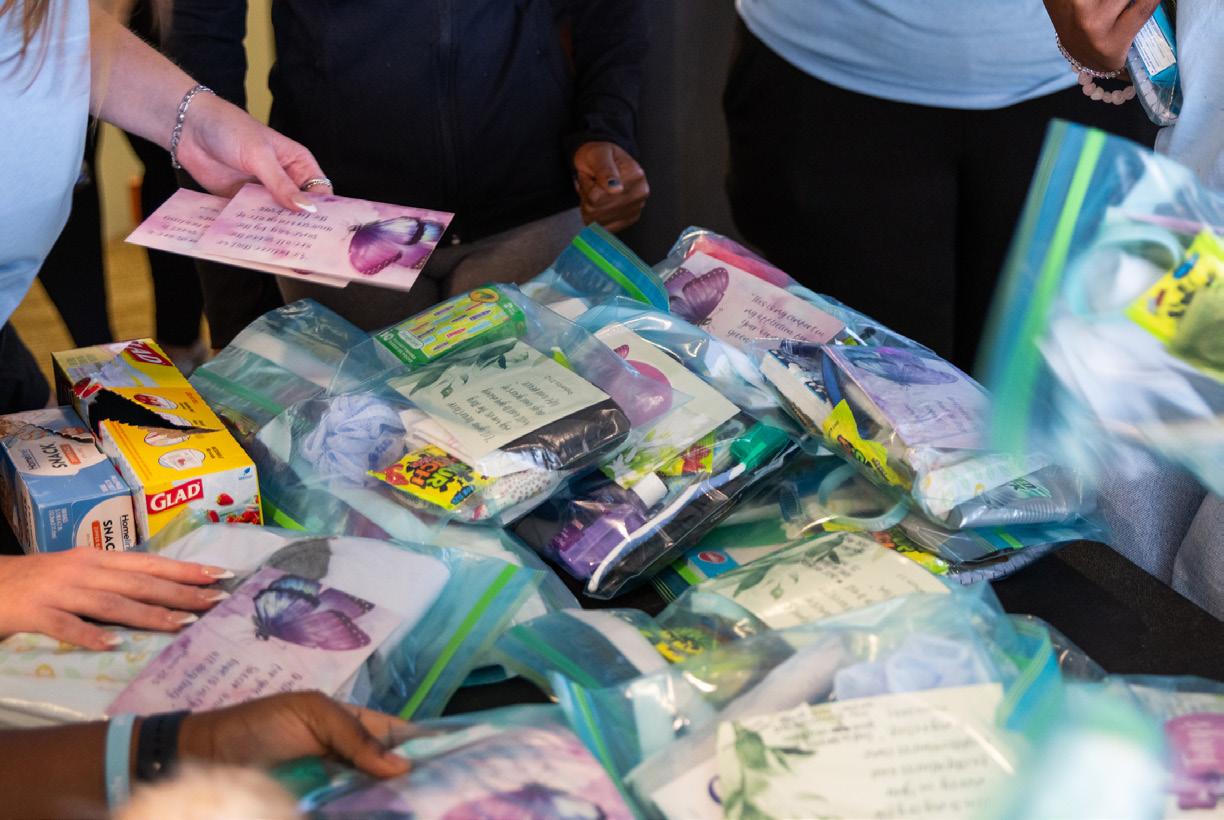
and her involvement in Greek life, including if she could manage the multiple commitments. However, after questioning the resolution was passed.
SGCR 86 appointing Benjamin Barousse to the Programming, Support and Initiatives Fund Committee passed by unanimous consent. SGCR 87 also passed by unanimous consent, appointing Mason Dobson to the Organi -
zational Relief Fund Committee.
The Student Senate also passed Sen. Joshua Jones’ funding bill to appropriate almost $2,000 for national transfer student week.
There were multiple ideas presented about supplying students breathalyzers on gamedays, and different bills asking for funding. These initiatives will be voted on further in committee meetings this upcoming week.
ALEXIS PERSICKE / The Reveille
An LSU Omega Psi Phi member gets pied Sept. 24 at Free Speech Alley in Baton Rouge, La.
ERIN BARKER / The Reveille
Volunteers sort through completed reentry care packages Sept. 27 in the LSU Student Union on Highland Road in Baton Rouge, La.
KALEY MELANCON / The Reveille
LSU’s chapter of Lambda Theta Alpha tables during National Hazing Prevention Week on Sept. 23 in Baton Rouge, La.
ERIN BARKER / The Reveille
Volunteers sort through completed reentry care packages Sept. 27 in the LSU Student Union on Highland Road in Baton Rouge, La.
ENTERTAINMENT

Thoughts on New York Fashion Week through a Tiger’s lens
BY SAVANNAH BOYNES Staff Writer

New York Fashion Week serves as a medium for trailblazing designers to showcase their unique, wearable creations, and the inclusion of Louisiana’s own Raising Canes’ spin on fashion design opens the conversation of NYFW from an LSU Tiger’s lens.
Using inspiration from the likeness of a chicken finger to even the beauty of its state flower, designer Joe Ando-Hirsch brought pieces of Louisiana’s culture to the runways of New York. In doing so, fashion becomes more approachable to the people of the boot-shaped state.
However, there are many Louisianians already familiar with the allure of fashion design. Sophomore apparel design and merchandising major Annalyse Vaughn described fashion’s meaning from her point of view.
“I think for me, I’ve always loved to see all the different ways people express themselves,” Vaughn said. “And yeah, just seeing all the different types of genres of fashion that have come from different types of people and how fashion changes through people’s like perspectives.”
Vaughn’s favorite designer from this year of NYFW is Anna Sui, who graced the runway this year with her delicate fabrics, distinctive patterns and varied color palette of soft blues and creams. Vaughn specifically emphasized her love for Sui’s belt designs, as well as how the designs altogether reminded her of ‘90s costume design from TV shows such as “Buffy the Vampire Slayer.”
As for the entirety of NYFW, Vaughn posited that the designs she saw could have included more variety in color.
“I definitely wish there was more color,” Vaughn said. “I saw a lot that kind of stick with just all like dark brown and black palettes.”
In terms of her perspective as a fashion student at LSU, Vaughn sees fashion itself as an art form because of the many different skill sets when it comes to designing, such as the drawing portion of designing and the technicality of sewing. She detailed how it takes a lot out of a person.
The fashion-related courses offered at LSU also strengthen Vaughn’s understanding of the innovative medium. She emphasized the amount of information they learn cannot be found outside of school, and her classes’ strict deadlines push students to practice as much as possible for their own ben-
efit.
She even recounted that her favorite memory in one of those courses has been learning about different fabrics and the science behind them.
“Right now, I’m learning just like the production of different fabrics, like wool and like leathers,” Vaughn said. “It’s kind of interesting to see the whole other world of fashions that’s just focused on producing fabrics.”
Vaughn believes people outside of the fashion bubble should know how the major has offered her many opportunities to look into, such as the Fashion Association and the Fashion Magazine. She described it as a close-knit community that one can make connections in.
While a lot can be learned from a fashion student perspective, graduate assistant Irina Pavlova offers insight into NYFW and the fashion world as a whole from a teaching standpoint. She taught Sustainable Fashion Thinking and Fashion Fabrics courses at Kent State University, though she currently teaches Introduction to Sewing here at LSU.
Pavlova feels strongly about what prompted her to pursue a career in fashion, mentioning the lack of self-expression present when she was growing up in Eastern Europe in the middle of the 2000s. She recounted the high conservatism and sexism that was present in the fashion and beauty industry, highlighting how everyone was trying to look the same.
“I always felt this need to, I don’t know, fight against the system because I always look different,” Pavlova said. “And I always wanted to give an opportunity to people similar to me to look however they want and feel comfortable in their bodies.”
As far as what fashion means to Pavlova, she said it is freedom. She underlined this interpretation with her teaching experience at LSU, describing how guiding a younger generation interests her because the way they think and see is more diverse. She said they do not follow fashion rules, and she respects them for that.
Pavlova said her favorite memory of teaching her sewing class is the students’ first garment collection. She said that part was touching for her because watching her students create their first unique garments within their own aesthetics was beautiful.
“When they start this course, most of them, they’ve never seen
a sewing machine before,” Pavlova said. “So, you know, seeing an actual fashion collection coming out of their fingers, and by the end of the semester, that was really cool.”
Pavlova believes fashion is selfexpression. She described the body as a canvas, saying that fashion is not only clothes, but it is everything one adorns oneself with. She accentuated how it is not such a simple process in presenting oneself, and it is not as flat as people perceive it to be.
However, she clearly drew the line between what fashion is as art versus what it is as commercial fashion. For Pavlova, she values the action of sustainability when producing fashion products. She said she appreciated the abundance of young and immigrant designers in the lineup for NYFW; however, her critique is that there could be more sustainable brands.
Pavlova’s favorite designer of the week is Eckhaus Latta, which offered looks of ravishing blackpalette designs and mostly darkcolored clothes with a splash of some cream and bright-colored looks in the lineup.
Her choice of this label was not only because of their aesthetic and tastefulness, but also because she thinks it is the most sustainable brand presented in the schedule this year. She respects their use of recycled and upcycled materials, saying it always looks good.
“I feel like they are really proving that you can make good wearable, fashionable clothing without harming the planet and our communities,” Pavlova said. “And this is what I have a lot of respect for.”
Regarding Raising Canes opening NYFW, Vaughn and Pavlova give their thoughts on Baton Rouge’s favorite chicken joint present in the influential week. Vaughn thought of it as a great branding opportunity, and the runway itself stuck to the brand well. As for Pavlova, she says she respects the homages to Southern heritage and culture.
In what’s important for people not affiliated with fashion to know, Pavlova expressed her belief in building a style that is true to oneself without adding to the destruction of the world.
“I think it would be great if people realized how important it is to develop your own personal style and your own relationships with fashion,” Pavlova said. “Instead of just blindly purchasing what’s intrend and what’s kind of easier to purchase right now.”




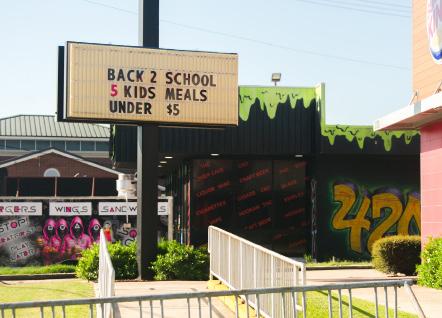

Welcome To The NEIGHBORHOOD
Just beyond the gates of LSU, the surrounding neighborhoods unveil contrasting imagery. Wide oak-lined streets sit proudly next to unkept, narrow blocks. Old, tattered homes are overshadowed by towering student apartments. In these varying neighborhoods, there is beauty, culture, history, divergent architecture and husbandry. The juxtaposition is striking; wealth, modesty, renewal and widespread neglect all exist side by side.
Baton Rouge has long been shaped by geography and history, from the Mississippi River dividing parishes to decades of segregation and uneven urban growth. This photo story is not meant to provide answers, but to invite questions: What does it mean to live in a city where these differences dance shoulder to shoulder?




Photo Essay by Pilar Franklin
Design by Jayden Slaughter
Cole’s Plaza is home to many businesses Sept. 24 in Baton Rouge, La. A building frames Coles Plaza Sept. 24 in Baton Rouge, La.
Two homes rest alongside one another Sept. 24 in Baton Rouge, La.
A back-to-school sign sits outside the Burger King near LSU’s campus on Sept. 17 in Baton Rouge, La.
A home sits near the west side of LSU’s campus on Sept. 16 in Baton Rouge, La.
A rose rests on the concrete on Sept. 24 along Lakeshore Drive in Baton Rouge, La.
New feminist book club is turning a page for ‘thought daughters’
BY LAURA ALLEN Staff Writer
LSU’s Thought Daughter Book Club offers a fun opportunity for students to analyze feminist and intersectional themes in literature, all in a safe and welcoming community.
The Feminists in Action club recently revived its book club under the new title Thought Daughter Book Club, with its first meeting on Friday, Sept. 26. The aim of the club is to read both fiction and nonfiction novels and analyze them through a feminist lens.
“Basically, it is the girls, gays and theys getting together to talk about books and have a good time and get to know each oth-
er,” said FIA President Lilli Sims, a senior psychology major.
Thought Daughter Book Club is starting off strong with “Yellowface” by R.F. Kuang, which follows Juniper Heyward as she attempts to pass off her dead friend’s manuscript as her own. The book explores themes of cultural appropriation, race and identity, giving the group plenty to discuss.
“My goal and my hope is to look at that and look at how race and gender may intersect, which is one of the big themes of our larger club — intersectional feminism,” said FIA Director of Diversity, Equity and Inclusion Temi Oduola-owoo, a senior mass communication major.
Oduola-owoo is the officer in
charge of running the book club. Having been a member since her sophomore year, the book club was what really got Odoulaowoo into FIA in the first place. Now a senior, the club officer hopes to reestablish the book club as a fun way for students to get involved in the larger club and meet new people.
At the first meeting, Odoulaowoo led a pre-book discussion over chocolate chip cookies, fruit snacks and soda, asking questions like “What defines cultural appreciation vs. appropriation?” and “Can we separate the art from the artist?”
These questions introduced the group to the themes in “Yellowface” and also prompted members to draw from their own
experiences concerning identity, media consumption and friendship in their answers.
“It is definitely about promoting critical thinking and thinking about books and how they apply in real life,” Odoula-owoo said.
Reviving this club was not without its challenges, however. Organizing and promoting the meetings, updating TigerLink, seeking approval from the club’s faculty adviser and preparing discussion material was a lot for Odoula-owoo to take on. However, she says that the whole process was ultimately worth it to create such a positive, safe space for open discussion.
“We are a safe space,” Sims agreed. “Like, you can basically say whatever you want.”
The club is scheduled to meet every Friday at 3 p.m. in the Women’s Center, and anyone is welcome to attend (yes, even men). Odoula-owoo hopes that by opening the club to anyone interested, Thought Daughter Book Club can become a fun, low-key environment for students to meet and make friends with students from all different backgrounds, all while discussing a good book.
“I am a big reader, and I always sometimes felt like ‘dang, I don’t have people to talk to about books at the same level,’” said Odoula-owoo. “So having a book club, especially with students here, is really cool. I love thought daughters. I love people who like to think.”
HOT OFF THE PRESS
A look inside how the Reveille gets printed
BY LANA LAWSON Staff Writer
When readers grab a copy of the Reveille’s latest issue, they may not realize there’s a bigger story that isn’t on the pages – it’s behind them. Beyond the purple and gold ink and bold front cover headlines, each issue is a product of giant machines, heavy rolls of paper and teamwork at the Baton Rouge Press.
The life cycle of a Reveille newspaper starts with the stories, of course. After stories are written by reporters and polished up by editors, they are then finalized for print. From there, the final prints are exported as a digital file and uploaded onto a secure server. This is where the printing press takes over.
After the press receives the files, their pre-press department downloads and checks these files for issues to make sure that the papers print correctly. If they are approved, those files are sent to a CTP (computer to plate) device that creates printing plates and runs proofs. The plates are then mounted onto the press and printed out for clients to use and distribute.
Baton Rouge Press handles over 75 different publications locally with an estimate of 100,000 copies printed daily. Stacey Coffing, the production and business

development manager at the Baton Rouge Press, has been involved in the print industry for over 40 years.
Coffing says that print has come a long way. She recalls when print was done through film strips and even before that people would use different machines like laser printers to copy and paste their stories to be printed.
The printing press gets very busy, with Wednesdays being their most action-packed days.
The various professional equipment takes a lot of effort to handle with the average roll weigh-

ing almost 1000lbs.
“Each person’s doing their part to get the job out, and it’s just steady,” Coffing said. “And there’s communication and people are talking to each other about what’s going on. These presses are big, and you have to pay attention to what you’re doing, or you can get hurt.”
Coffing mentions that while printing with the equipment runs smoothly most of the time, there are some instances where things can go wrong.
“When you’re in a newspaper industry, where everything
is news, your deadlines are really tight and your turnarounds are really tight,” Coffing said. “So if you incur equipment issues, you can miss a deadline. Nobody wants to read old news, right? They want to have current news. So it’s very critical that the equipment works and works properly.”
There aren’t many printing presses still around, so attaining materials for print isn’t as easy as it used to be. The Baton Rouge Press sources some of their materials from paper mills out of state and even out of the country.
Baton Rouge Press has been
printing out the Reveille for over 12 years.
“I think that the commitment by the Reveille to get the news out to the students has been good,” Coffing said. “There’s a lot of other colleges that don’t have that same commitment, and you see a lot of them struggle.”
Coffing says that there are a lot of stories that she finds connections to. She takes pride in the fact that she can walk into an establishment and find work that she’s printed herself. She believes that because there are so many niches that require physical copies, print will remain in demand.
“I think there’s still a place for the printed word,” Coffing said. “I think that college students would rather read a book than read a computer. So I don’t think that print is dead, but I definitely think it has gotten smaller. I can see the change from how I grew up and how my kids are growing up, but not all change is bad. Things change, and you have to go with it. “
The life cycle of a Reveille newspaper is vast and intricate, transporting from the newsroom, to the pressroom and finally into newsstands. Next time you pick up a copy, remember it’s more than just a paper printed with ink. The Reveille represents hard work and dedication from everyone who brings it to life.
COURTESY OF BR PRESS
SPORTS

3TAKE AWAYS
LSU football freshman running back Harlem Berry (22) celebrates after scoring his first career touchdown during LSU’s 19-24 loss to Ole Miss Sept. 27 at the Vaught-Hemmingway Stadium in Oxford, Miss.
What we learned from LSU’s road loss to Ole Miss
BY CHLOE RICHMOND Sports Editor
LSU versus Ole Miss was an opportunity to make a statement. The winner would stay undefeated and come out with a ranked SEC win, proving it’s worthy of candidacy for postseason play.
Unfortunately for the Tigers, the Rebels wanted it more and took the game 24-19. Ole Miss was able to expose LSU’s weaknesses and quickly took advantage of a tired defense to punch in more points as the game went on.
Here are three takeaways from another offensively disappointing game from LSU. Defense is legit, but can’t win it all
The script has read the same for LSU for much of the season: the defense holds off opposing teams’ offenses just long enough for LSU’s offense to get going.
This time around, it wasn’t enough. The defense did what it was supposed to do, but it can’t be expected to win the whole game.
“Our defense was able to get stops early on, and we needed to take advantage and we didn’t,”
quarterback Garrett Nussmeier said.
Despite a strong effort from the unit, having a defense out on the field for too long chips away at its stamina. Blake Baker’s squad did all it could for as long as it could, the offense just couldn’t rise to the occasion.
LSU still can’t handle a running quarterback
In last season’s Texas A&M loss, the Tigers were disgruntled when Mike Elko threw in Marcel Reed; he hit the ground running and led the Aggies to a second half comeback win after rushing for three touchdowns and 62
LSU soccer wins first SEC game at Auburn, despite weather delays
BY TRIPP BUHLER Staff Writer
As lightning bolts took over the Auburn Soccer Complex on Thursday night, LSU soccer took over the pitch with heat-seeking goals in a 3-1 win over Auburn, which concluded after an almost threehour-long weather delay.
Entering this game, LSU’s promising non-conference results were being whisked toward obscurity by a scoreless tie and two onegoal losses to open SEC play.
The stark issue was the offense not completing opportunities in front of the opposing goal, but the Tigers took those shortcomings seriously on Thursday.
The three goals LSU netted at Auburn were the most they have
scored in an SEC game this year and only the third time they have scored that many all season. With help from the offense, the defense was able to do what it has done best all year.
Auburn kept the ball on offense for the majority of the match, continuously getting down the field and taking shots. The home Tigers ended up outshooting the visitors 22-6.
Shots poured in, but Auburn was only able to put seven of those on goal.
LSU goalkeeper Sophine Kevorkian started for the first time in three weeks and was lights out in the first half. She and the defense gave the purple and gold a chance to move forward on offense.
After LSU missed a corner kick
wide left, the loss of possession led to another bombardment from the Auburn offense. Five shots poured in quick succession, but none forced Kevorkian to leave her feet.
LSU head coach Sian Hudson gave a stress-filled wipe to her face as Ida Hermannsdottir lined up to inbound the team’s third corner kick of the game. A high kick pinballed four times in the middle scrum before bouncing outside the box.
Finally, defender Sydney Cheesman fired a missile off her right foot into the top left corner of the goal, out of reach of Auburn keeper Ayana Yapo. Cheesman’s teammates ran to celebrate with her after the senior scored her first goal
Volleyball walk-on receives scholarship
BY MARISSA REISS Staff Writer
“Is it actually me?”
Those were the words LSU volleyball junior libero Ella Hemmings said when she opened a letter during practice that contained a huge secret: she was being put on scholarship.
When Hemmings showed up to practice on Sept. 2, she was confused as to why she was mic’d up. She was told it was for film and the team was receiving letters, which she said she thought were probably from alumni.
When Hemmings opened her letter, the words on the paper read, “Congratulations Ella, you’re on scholarship.” She didn’t piece two and two together at first, thinking all of her teammates’ letters had said the same thing.
yards.
This Ole Miss loss was the same film with the same ending. Ole Miss came out the gates with a mobile quarterback that wasn’t afraid to make a quick decision. Ferris State transfer quarterback Trinidad Chambliss rushed for more yards than LSU’s entire offense combined.
Chambliss’ 14 rushing attempts continued to put the Rebels in good field position time and time again, and the LSU defense just couldn’t track him. He also outperformed Nussmeier by a mile in this category, who only had two attempts for a loss of seven yards.
It might be time to play with a different quarterback
With the Tigers down 17-7 going into the half, it was clear that the offense wasn’t clicking. An easy fix to that would’ve been throwing in Mississippi State transfer Michael Van Buren.
Van Buren saw his most action of the season against Southeastern, and he proved to be a running force. Although he only rushed for 16 yards, he was able to bring in a touchdown of his own and ended the night 10for-12 on pass attempts. He also threw for 122 yards.
“[Ole Miss’] quarterback made plays,” LSU linebacker Whit Weeks said. “It comes down to that. We were in position to make a play and just didn’t execute.”
Now, it’s pointless to rest on the what-ifs in sport, but it’s also easy to wonder how different this game could’ve been if a fresh spark on offense was thrown out there.
One of her teammates called out from a distance, “One of your teammates is being put on scholarship,” and Hemmings was brought to immediate tears.
That’s when Hemmings looked at her coaches in disbelief, asking if it was actually her being placed on scholarship — to which they answered yes.
“My stomach just kind of dropped,” Hemmings said. “It was one of those moments where it’s like, ‘Huh? Really?’”
Hemmings committed to LSU as a walk-on out of high school after touring the university. She immediately fell in love with the program and Baton Rouge, leaving her visit sobbing because of how amazing she thought the place was.
“There were no questions asked,” Hemmings said. “Coming somewhere where I knew I was going to get a fresh start and where I was going to be able to build something for myself outside of just volleyball was a big reason why I came here.”
Often there are misconceptions about walk-on athletes when it comes to the process of playing at the collegiate level. Walk-on and scholarship athletes at a university do the exact same things, scholarship money is just an additional benefit.
Hemmings knew that she might not get the money she was looking for as a college student, but that was okay in her decision to play for the Tigers. LSU is a place where Hemmings knew she would get so much more out of the university and what the athletic program provided, she said.
The coaching staff and teammates surrounding Hemmings was
PAYTON PRICHARD / The Reveille
WOMENS BASKETBALL
Meet eight new additions to LSU women’s basketball’s fall roster
BY ISABELLE CALLAHAN Staff Writer
The LSU women’s basketball team, led by fifth-year head coach Kim Mulkey, is back on the court with its eyes on the road to Phoenix for the national championship.
This time around, there’s eight new faces on the roster of 13. With a blend of top-tier transfers and freshmen from all over the country, LSU is ready to make a statement this season.
Making her way from Columbia, South Carolina, after competing for two seasons with the Gamecocks, Fulwiley will provide an advantage to LSU’s backcourt.
She averaged 11.7 points per game, 2.8 rebounds and played
Coming all the way from Ukraine, 6-foot-5 forward Kate Koval transferred in from Notre Dame after playing for the Fighting Irish for just one season.
MILAYSIA FULWILEY
a total of 39 games at South Carolina. Known for her quickness, court vision and ability to attack the basket, she earned the honor of SEC Sixth Woman of the Year,
SCHOLARSHIP, from page 9
another reason for her to love the Tigers. She said she’s been under the guidance of the best coaching staff in the country, and they truly strive to show how much they care for and value each and every player on the team on and off the court.
As for her teammates, Hemmings sees them as her sisters. They’ve been there for her since the very beginning of her time in Louisiana, and they mean everything to her.
The video from practice received a huge amount of national attention, to which Hemmings was a bit overwhelmed by. She had nothing more to express but gratitude.
“I’m really thankful to be a part of a program that has always and continues to show how much they value me,” Hemmings said. “They’ve done a great job of that over the past two years, scholarship or not.”
KATE KOVAL
Koval is a versatile post presence with her size by shot-blocking and rebounding ability. It’s no surprise she made her way down to the boot as Mulkey and the Tigers went after her in high school. With an average of 5.3 points and 4.7 rebounds as a freshman, she showcased her defensive instincts and efficiency, playing
AMIYA JOYNER
A transfer from East Carolina, this 6-foot-2 senior forward adds a new depth to the Tigers’ frontcourt with not only scoring but her size as well. At East Carolina, Amiya Joyner showed strong rebounding and midrange scoring ability with an average of 15 points per game, which will complement LSU’s interior mix. Her athleticism allows her to guard multiple positions and contribute in transitions, fitting into the fastpaced style that Mulkey is a big fan of. Joyner’s experience as a senior trans-
A freshman from Nevada who completed her high school career in California, Grace Knox is a versatile forward capable of stretching the floor and battling the inside. She’s a four-star recruit ranked in the top 10 by ESPN.
All the way from Iowa, Divine Bourrage is a highly-rated guard with elite scoring and playmaking abilities. She averaged 19.8 points, 9.3 rebounds, 5.6 assists and 3 steals throughout her junior season, in which she was
As one of the most decorated athletes in the history of Kentucky high school sports, ZaKiyah Johnson brings size and considerable defensive potential, with a history of winning gold medals at the Team USA U18 FIBA Women’s Americup and numerous other accolades.
Bella Hines is a scoring-oriented guard with experience leading her high school team. She’s ranked in the top 30 nationally and excels in shooting, ball handling and driving to the basket, accumulating 2,000 career points during her junior year.
Meghan Yarnevich, a freshman from Maryland is a versatile forward who can stretch defenses with shooting and attack inside when called upon. Yarnevich adds depth and flexibility to LSU’s frontcourt, complementing
Her experience in high-pressure SEC games also provides an added bonus to this 5-foot-10 guard’s skillset.
GRACE KNOX
Knox excels at scoring in transition, hitting those mid-range jumpers and crashing the boards.
Her 6-foot-2 height and skill set make her an ideal fit for the LSU roster, which values versatile forwards who can defend multiple positions.
DIVINE BOURRAGE
Bourrage is also ranked in the top 15 nationally as an incoming freshman. She can handle the ball well with the ability to play all
As a top-15 national recruit, she’s capable of creating shots, finishing at the rim and becoming a potential two-way contributor early in her career. She will provide depth behind the established guards LSU has, and adding this type of flexibility and defensive
“I wanted to be a part of a winning program and I know with coach Mulkey I can do that,” Hines said in an LSU Athletics press release. “A big part of why I wanted to play for coach Mulkey is because she cares more about me as a per-
Knox and Koval.
She’s a strong rebounder and capable scorer, which she proved after averaging 10.3 rebounds per game through 48 high school games. Her high school experience at a competi-
LSU fans can expect her to be a key rotation piece, providing scoring opportunities while also stabilizing the guard rotation alongside teammates Flau’jae Johnson and Mikaylah Williams.
585 minutes of game time.
Her frame gives LSU the inside presence it lost with the offseason transfers out. Koval’s towering height allows her to protect the rim and contribute offensively at the basket.
fer gives her the mentality to adapt quickly to SEC opponents, helping balance a roster with younger talent.
You should expect her to play a significant role in relief of Koval and the incoming freshman forwards, contributing on both ends of the floor.
Knox’s high school career was decorated with state championships and All-American recognition, preparing her for not only the collegiate level but also the tough slate of SEC opponents. She brings toughness and the drive to LSU’s rebuilding frontcourt.
three guard positions and score from anywhere on the court.
With the versatility at her size and being able to play multiple guard positions, this gives Mulkey the flexibility within roster rotations.
playing off the bench will be a big help.
Johnson’s ability to stretch the floor and guard the taller posts is a key asset in LSU making a return to the Final Four, where she can be a big help with her versatility and quick transitions.
son and my education than just a basketball player.”
Hines has a strong mindset about playing to the best of her abilities and she can adapt to multiple guard roles, making her a contributor as a playmaker or off-ball scorer.
tive program such as the Bullis school helped in preparation for the SEC.
Yarnevich brings size with her 6-foot frame and additional skill to the roster in a transitional period for the Tigers.
“My teammates are my best friends,” Hemmings said. “For them to be there for that moment was especially heartwarming. The four of us that were here two years ago — Jurnee [Robinson], Angie [Lee] and AC [Froelich] — we’ve been through everything together.”
Having a huge support system around her is something that Hemmings is extremely appreciative of. To her, being a part of this program is about more than volleyball.
“Yes, we’re here for volleyball, but at the end of the day, it’s way more than that,” Hemmings said.
“It’s about who you are as a person, who you are off the court, how you represent LSU and the connections that you make.”
The opportunity to receive a scholarship her junior season was a weight off of Hemmings’ shoulders. For most college students, money is an important factor, and not having to worry about it is something that students juggling academics find comfort in. To receive an athletic scholarship was a relieving feeling, she said.
SOCCER, from page 9 of the year and only second of her career.
A couple of substitutions and passes ended the first half with LSU ahead 1-0.
Bad weather loomed as the second half got underway, but play was not stopped in an attempt to finish the contest before lightning reached within eight miles of the stadium.
Auburn got its chance when a free kick was cleared in front of the LSU net before being sent back outside the box. A rushed and contested shot from Auburn’s Erin Flurey almost matched the distance of Cheesman’s, as Flurey sent a rocket to the top side of the goal.
The hot shot tied the game at one in the 53rd minute.
Both cats then clawed their way toward a lead, but wouldn’t get a chance until LSU’s 67th-minute pass into the penalty box.
Ava Galligan rose up and delivered a header with perfect accuracy into the top left corner of the goal. She netted the go-ahead goal for her sixth of the year, continuing to be the most reliable goal scorer for LSU.
The LSU offense finally found its rhythm inside the penalty area, the place where its offensive attacks went to die in previous games.
In the 70th minute, with LSU up 2-1, the game went to a weather delay. The two teams agreed to wait it out and attempt to finish the
For other walk-ons like Hemmings, her story is a testimony that going somewhere where you feel appreciated and can play to your best ability, regardless of scholarship, can amount to something great. She’s thankful for the scholarship, but getting to meet some of her best friends and play in a caring program was already everything to her.
Hemmings had no idea what college volleyball was going to look like for her coming out of high school, but she reminded herself of one thing: bet on herself.
No one in Hemmings’ family had ever played at the collegiate level, and she didn’t know what to expect for her next four years. Still, she took a risk and believed in herself anyway. At the end of the day, she said she knew that every risk she took was going to turn into a lifetime memory.
“I’m probably not going to even remember any digs I had or any service passes,” Hemmings said. “I’m going to remember all the memories and how thankful and grateful I am to have taken the opportunity to come here.”
game that night. That wait lasted two hours and 45 minutes.
As the storm ended, the restlessness coming from each locker room was palpable. Both teams returned to the field and resumed play at 10:30 p.m.
Auburn got the first real opportunity to score after the delay, when Gracie Brown shot from about 45 yards out. Kevorkian had to jump to her right to make a stellar save, keeping the lead for LSU.
The page turned when LSU had an offensive breakaway on the left side of the field from freshman sensation Sariyah Bailey. She delivered two beautiful touches to avoid Auburn’s defender and goalkeeper and shot on an open net to seemingly put the dagger in the game.
Kevorkian and the LSU defense were put to work in the final 10 minutes, with Kevorkian making three saves, but the senior goalkeeper made it look easy and LSU secured the victory.
The victorious Tigers brought home three points in the standings and left Auburn with their first win on the Plains since 2009.
LSU had the weekend off and will next face Missouri at home on Thursday, Oct. 2, at its annual pink game.
The Tigers had shown resilience earlier in the season, but for the first time, demonstrated their ability to score clutch goals and win crucial games against conference opponents. Hudson has her team in a good spot to keep earning points for the SEC tournament.
named the National Gatorade Player of the Year in her home state.
ZAKIYAH JOHNSON
BELLA HINES MEGHAN YARNEVICH
RFK perpetuates eugenics under the guise of public health

SAVOY’S SCOOP
CADE SAVOY Columnist
Since Leo Kanner first described his classic “autism syndrome” in 1943, scientists, physicians and concerned parents have pondered a perplexing question: What causes autism?
If you ask Department of Health and Human Services (HSS)
Secretary Robert F. Kennedy Jr.,

the answer is just about everything. Since his political ascendance in 2020, the nepo babyturned-anti-vax guru has linked autism to flu vaccines, food additives and — as of Sept. 22 — an active ingredient in Tylenol.
To no one’s surprise, he’s probably wrong. Ann Bauer, a coauthor of the meta-analysis HSS, cited in its official fact sheet on the subject that the Department’s conclusions were ill-founded. Critics have also pointed to a laundry list of studies that strongly refute the connection between Tylenol and autism.
The same goes for flu vaccines and food additives. According to the Mayo Clinic, “autism spectrum disorder has no single known cause.” Medical experts have spent decades trying to determine how genetic and environmental factors affect a child’s likelihood of being diagnosed with autism, but the jury is still out.
That still hasn’t stopped RFK from making false promises. This April, the Health Secretary promised to find an environmental cause of the “autism epidemic... by September.”
I’m not holding my breath.
My Halloween decorations are al-
ready up.
But my objection to RFK’s fear mongering isn’t just that it’s rooted in bad science; it’s that it perpetuates eugenics under the guise of public health. By treating autism like a terminal diagnosis while turning a blind eye to measles outbreaks in Texas, Kennedy rhetorically constructs autistic children as threats to society.
This playbook isn’t new.
Hans Asperger, the German scientist who is credited with discovering his namesake syndrome, made his career as one of history’s most famous Nazi doctors. An outspoken eugenicist, Asperger spent decades running “factories of death” — hospitals where neurodiverse children were diagnosed and then systematically euthanized.
Asperger believed that autistic children undermined the Nazi Party’s values. He explained that while neurotypical children socialize and follow the rules, autistic children are too quick to question authority and, by extension, genetic anti-fascists.
To be clear, I’m not calling RFK an outright Nazi. That’s Elon Musk’s special interest.
I will say, though, that his
rhetoric employs Nazi tropes to justify governmental overreach. While Kennedy has certainly yet to ask the Food and Drug Administration (FDA) to open concentration camps, his narrative actively harms autistic people and their families in two significant ways.
First, it’s blatant misinformation. There is no “autism epidemic.”
The National Institutes of Health refutes the assertion well: “No sound scientific evidence indicates that the increasing number of diagnosed cases of autism arises from anything other than purposely broadened diagnostic criteria, coupled with deliberately greater public awareness and intentionally improved case finding.”
But even if it were true that a higher proportion of children have begun exhibiting autism symptoms, it would be inaccurate to characterize the phenomenon as an epidemic. Oxford Languages defines an epidemic as “a widespread occurrence of an infectious disease in a community at a particular time.”
Autism is not a disease, and the Health Secretary’s choice to characterize it as one elucidates
the second harm of his political charade: it stigmatizes diagnosis.
From a young age, autistic people struggle with being different: they think differently, they act differently, they may even speak differently. Receiving a diagnosis can help autistic people learn to embrace their neurodiversity and develop mechanisms to manage meltdowns and make ordinary social interaction easier.
Since autism is incurable, treating it as a disease may inadvertently deter neurodivergent people from seeking diagnosis.
Considering that the National Institutes of Health finds that 60% of autistic people who are diagnosed as adults report experiencing suicidal ideation, it’s more important than ever that we create safe spaces for them — including at the Department of Health.
It’s time we stop treating neurodiversity as a glitch. It’s not. Neurodiverse and autistic people are every bit as worthy of love and acceptance as you and me.
Plus, they’re anti-fascists. And I think that’s pretty punk.
Cade Savoy is a political science and philosophy major from Breaux Bridge, La.
It’s time to party smart — having fun is a collaborative effort

BODACIOUS
BLAIR BERNARD Columnist
Louisiana State University, land of football and home of college’s most iconic nightlife. I have definitely earned my badge of honor, scratching off the majority of my partying bucket list. What Baton Rouge constantly reminds us students, though, is to expect the unexpected and the dangerous.
Gameday weekends are no joke in Death Valley. The bar scene here is pure chaos. We’ve got people coming from all over to get a taste of the real deal, meaning our beloved college town bar, Fred’s. But I fear we might have 365-party-girlbossed too close to the sun.
This idea of overdoing it and underdoing our safety has remained prevalent to me, having experienced one of my most stressful night outs ever; I found myself, unfortunately, in a sce -
EDITORIAL BOARD
Jason Willis Editor in Chief
Olivia Tomlinson
Managing Editor
Courtney Bell News Editor
Chloe Richmond
Sports Editor
Garrett McEntee Opinion Editor
nario where I was at risk of being unsafe. I was around belligerent, intoxicated people, left with suspicious ways to get home and overall in bad company.
Students want to go out and drink and enjoy themselves. Yes, I think from personal experience we’ve just all got a bit too comfortable with the “for the plot” trope. If the plot entails putting my life in unnecessary danger, count me officially out.
Baton Rouge isn’t the safest city out there. I think we can all recognize that. Sometimes I feel anxiety just leaving my house for class. Feeling safe when going out? Forget about it.
There are more horror stories to count. Specifically concerning the safety of young women on LSU’s campus. Our community recently suffered through a horrific tragedy as a student body: the death of Madison Brooks. Doing what every other teenage girl was at the time, Brooks was at the bar enjoying her night until everything took a deadly turn.
The crime committed against
Brooks was no mistake. A vulnerable young girl was plotted against at no fault of her own. But, I can’t help but wonder if the tragedy could’ve been avoided had the bars or people around her been more alert in her time of need. How many stories like Brooks or other victims could’ve taken a different turn?
I feel guilty that Brooks had an experience that cost her her life. I think as students continuing to move on with our lives, we all have a bit more responsibility to take more precautions.
Before a night out, have a checklist: Who’s coming? How are we getting there? How are we getting home? And continuously check on your friends and peers as the night advances. This is honestly the bare minimum.
It makes me so sad to see friends putting other friends in danger by allowing themselves to get to the actual point of alcohol poisoning. Not only can no one enjoy their night out because you have to babysit your bestie but, your friend is now
incredibly vulnerable and at risk of being hurt or worse, and let’s be real here, it’s up to you to help your friend because the frat president certainly won’t. What hurts even more is seeing girls not looking out for other girls. For example, letting one another get incredibly drunk and just leaving them vulnerable. We have to do better.
Now, we can all acknowledge that nightlife in Tigerland is mostly Greek life, unless it’s a gameday. Sorority girls and frat guys are some of the most privileged of the student body to be frank. So, I get their whole “I’m invincible” MO, but it’s honestly annoying and ignorant. Ignoring the treachery that may meet us at Tigerland doesn’t make you cool.
Next time you go out, don’t forget to make that checklist. Don’t forget to look out for your friends and even those that aren’t your friends. Having fun is a collaborative effort. Don’t be one of those people who abandon all morals when you’ve
Editorial Policies and Procedures
The Reveille (USPS 145-800) is written, edited and produced solely by students of Louisiana State University. The Reveille is an independent entity of the Office of Student Media within the Manship School of Mass Communication. Signed opinions are those of the author and do not necessarily represent the views of the editor, The Reveille or the university. Letters submitted for publication should be sent via e-mail to editor@lsu.edu or delivered to B-39 Hodges Hall. They must be 400 words or less. Letters must provide a contact phone number for verification purposes, which will not be printed. The Reveille reserves the right to edit letters and guest columns for space consideration while preserving the original intent. The Reveille also reserves the right to reject any letter without notification of the author. Writers must include their full names and phone numbers. The Reveille’s editor in chief, hired every semester by the LSU Student Media Board, has final authority on all editorial decisions.
had a few drinks. One tragedy is already too many. Be safe out there, Tigers.

“Some things I cannot change, but ‘til I try I’ll never know.”
Blair Bernard is a 21-year-old theatre major from Lafayette, La.
ALEXIS PERSICKE / The Reveille The crowd cheers Sept. 5 at Fred’s Bar & Grill in Baton Rouge, La.
GRAPHIC BY CARMEN FAJARDO
Poetry is a misjudged art. Substitute it for your doomscrolling

RILEY’S REVIEW
RILEY SANDERS
Columnist
Gone are the days when society engaged with long-form literature and other mediums of human expression through the monoculture. With practically unlimited access to people all over the world, and with the constant availability of digital content, there are far too many avenues of stimulation from which we derive satisfaction.
We are simultaneously becoming less engaged with each other and ourselves while somehow convincing ourselves we are more connected than ever. Millennials and Gen Z have suffered the brunt of the damage of the digital age, as this has largely been the means of exposure to the larger world for our generations.
Only a few decades ago, prior to widespread access to the internet, nearly 20% of Americans read long-form literature, in particular poetry and prose, as a means of connecting with the world around them. Today, unfortunately, this is no longer the case. A 2025 study conducted by the Walton Family Foundation found that around 43% of Gen Z students say that
they “rarely or never read for fun.”
This alarming trend has become obvious as our youth have become more and more captivated by connection through 30-second TikTok videos, short and unsubstantive smut novels and “brainrot” in general.
In light of recent events, there is clear evidence that we are becoming more divided and less understanding of each other and ourselves as individuals vs. pawns of political parties, faux-religious organizations and other problematic groups; however, I think we are all due for more self-reflection as a means of maintaining our empathy and our humanity even, and poetry offers an opportunity for this growth.
Most people today would hear the word “poetry” and cringe. For many, poetry was an assignment, a chore, one grade out of a hundred in their high school English classes. Meghan Sullivan, an LSU (introduction to poetry) instructor, however, argues that poetry is actually “an opportunity to learn about others and about the curiosities of life that plagues [us].” I’d be inclined to agree.
You’ve probably heard of those considered history’s greatest poets: William Shakespeare, Edgar Allan Poe, Emily Dickinson, Robert Frost and more. There’s a de -

cent chance you’ve hated them. There’s an even greater chance you’ve misunderstood them.
The beauty of poetry is how personal it is not only to the individual who writes it but to the individual who reads it. Unfortunately, reading required literature for a class often removes any personal impetus to enjoy it and increases the likelihood that you will be unwilling to understand it. Sullivan believes that this is an unnecessary “chore” of poetry and that we ought to “relieve ourselves [of the] pressure of understanding.” Rather, we ought to entertain poetry and other literature as something to be absorbed
and not necessarily immediately understood.
Often, we consume poetic work without even realizing; “lines in TV shows,” lyrics in your favorite song and more are often intentionally written and placed as a means of tugging your subconscious, your heart, your mind, your entire being. People are closer to poetry than they realize.
Take, for example, Taylor Swift’s “mirrorball”, a song about living performatively for the sake of people-pleasing. How could one more beautifully communicate this idea than by comparing themselves to the likes of a disco ball of all things (“I’ll change ev-
erything about me to fit in…as they watch my shattered edges glisten”)?
Or how in Frank Ocean’s “Godspeed”, he sends a loved one on their way with a goodbye compared to “let[ting] go of a prayer.” Poetry is not inaccessible; rather, it is misrepresented and misunderstood as a stringing together of words, too intellectual to be useful and too difficult to understand to be personal.
I encourage you, next time you feel the urge to doomscroll or to lose yourself in endless, meaningless content — look up Dylan Thomas, Sylvia Plath or even Lana del Rey’s “Violet Bent Backwards Over the Grass” (yes, she writes poetry outside of her musical discography). You could even look up southern poet KB Brookins or LSU’s very own Maurice Carlos Ruffin, both highly recommended by Sullivan.
Poetry is all around us, and you will never feel that you need it or that you can understand or enjoy it if you do not dip your feet in the water a few times. The right poem will find you — all you need to do is take the time to read.
Riley Sanders is an 18-year-old biology major from Denham Springs, La.
Feeling like you’re stuck in a rut? You should try side-questing

Have you gone on any spontaneous side quests this week?
College isn’t solely about living the same day over and over again. A lot of students get stuck in a cycle of going to class, studying and sleeping — that’s it.
The creator known on Instagram as @earthfairy.b has labeled herself “the college side quest queen.” She is passionate about students spending time exploring all that their college campus has to offer them.
I agree.
While having a healthy schedule of classes, studying and sleeping are important aspects of college life, it shouldn’t
be the only thing you do with your time at university.
Disclaimer: I know some of my classmates have to prioritize working over joining clubs. If this is your scenario, no need to feel discouraged. Work is a great avenue to meet other students, network and be a part of something just like one would in a club. Keep going, I’m proud of you.
When all is said and done, everyone should be able to reminisce on their college days, grateful they did more than just study and hit the bars every night.
Take chances, put yourself out there; you never know what could become of that one club meeting you attend.
There are still so many potential opportunities for you, even if your schedule doesn’t al-
low much time for various organizations.
It’s vital for you to make the most of your classes. Deliver outstanding projects, participate consistently and take a genuine interest in the material.
I was offered my first internship after taking a course in the spring of my freshman year. I completed a project that showcased my skill set and abilities. And sure, it was a class assignment, but I treated it as if it was a task for a client.
As a result, my professor extended a paid internship to me, and next thing you know, I was working for a PR firm as social media manager for a TLC reality star on “90 Day Fiancé: Love in Paradise.”
LSU offers over 400 student organizations; surely there’s a little something for everyone to

dabble in.
It’s time to take advantage of the opportunities right under your nose, especially if you’re a freshman.
As a senior, I have been taking it all in, studying at my favorite spots on campus rather than being cooped up in my apartment, making sure I’m participating and being present during my last fall semester.
How is one supposed to meet new people and encounter new experiences if you don’t explore campus and engage in conversation with fellow classmates, professors and faculty?
Since being at LSU, I have been blessed with amazing opportunities and have said yes to pretty much all of them.
Despite concentrating on more writing opportunities and fewer photography focused ones, I have used my photography skills for the Manship School during my freshman year and my pictures remain on their website and Instagram till this day because I said yes.
When the opportunity to apply for the role as social media manager for Fashion Association at LSU found its way to me, I said, “What the heck? Sure.”
Mind you, I’m not even a textile, apparel and merchandising major.
As a fashion lover, it made for a great experience dipping my toe into waters I didn’t even know existed at LSU.
If it weren’t for side quests,
my career at LSU wouldn’t be half as eventful as it has been.
One Sunday following a game day in my sophomore year, I went from recognizing actor Jay Ellis on the side lines in Tiger Stadium to conducting an interview with him at his new Pilates studio in Baton Rouge.
That interview was during my days as an entertainment reporter for the Reveille. Just a casual Sunday afternoon, no biggie.
All this to say, none of the opportunities mentioned throughout this article came about because I embraced the class, study and sleep only cycle.
And heed my advice, definitely don’t get caught up in trying to make your college experience identical to anyone else’s.
Instead, focus on what you want to do, not just the activities that are commonplace.
Find organizations and events taking place on and off campus, even if it’s the things that fly under the radar most of the time. Also, if you have interests that aren’t readily available, why not create your own opportunities? You can always volunteer your expertise to peers, faculty and organizations in order to develop your role that might not yet exist.
Until next time, live, love, laugh, side quests!
Ava Francis is a 22-year-old journalism major from New Orleans.
GRAPHIC BY CARMEN FAJARDO
AVA’S POV
AVA FRANCIS Columnist
GRAPHIC BY KALEB SEARLE
